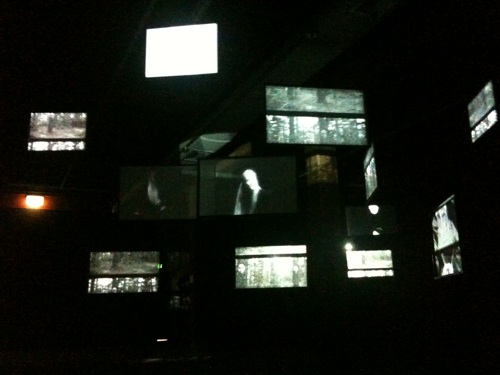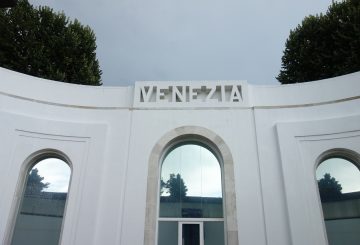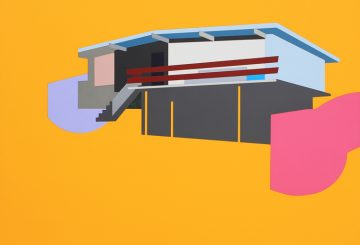Ryan O’Donnell considers two new exhibitions at Artspace – Ms&Mr’s Grandfather Paradox and Sam James’s Amygdala: Fear Conditioning… One is great, another is perhaps not so great…
Following SuperDeluxe’s Biennale residency Artspace has kicked off its new exhibition season with two new compelling solo video installation exhibits. Featuring Australian video artist Sam James, and Australian/Canadian born collaborative duo Stephanie & Richard nova Milne (better known as their combined pseudonym Ms&Mr), the works grapple with memory, space, time, and reality itself in an engrossing manner.
With a history in performance documentation, James visits his past in Modes of Misunderstanding 1 & 2 (2010), and the exhibition’s eponymous piece Amygdala: Fear Conditioning (2010). Ms&Mr continue to engage questions of time and space in their latest multi-media project 808.838/grandfather paradox (1967-1977/2010). Paradox is the pair’s most recent manifestation of what they call “retroactive collaboration”, a process wherein the pair weave together old home movies and other childhood fragments to create new alternative time-lines and possible worlds within the digital realm.
VHS, DV, HDV, Motion jpeg. 20 Minutes.
Upon entering the space, to the immediate right is James’ Modes of Misunderstanding I & II. This body of work is displayed across two walls, the first of which features a large-scale video projection, Modes of Misunderstanding I. In contrast to this immensity, Modes II is confined to a small plasma television on the adjacent wall. Visions of the vast and unforgiving Australian landscape are juxtaposed against images of suit-clad aristocrats trudging through their harsh surroundings. James has digitally interlaced archival footage produced by white, upper class Australian artists who have attempted to grasp the Australian identity through the Australian Landscape. Here James demonstrates these artists’ attempts as inherently absurd, pretentious, and misguided. The artists have been depicted as lost in the very landscape they wished to represent.
Whilst conceptually both pertinent and humorous, I however found this body of work to be somewhat lacking aesthetically. The video content was unengaging, and almost indistinguishable from the footage that spawned it. Unless you were aware of the fact that the piece is comprised of existing footage, the piece is ultimately just as uninspired and pretentious as the works that inspired it. When compared to James’ other piece on display, Amygdala: Fear Conditioning, this piece leaves a lot to be desired visually.
Turning right into the next room, all external light is extinguished as you enter Amygdala. The Amygdala is the component of the brain that links memory and emotional response. Using the Amygdala as a structural foundation for this installation, James has taken unstructured, chaotic images and reassembled them to form a functional, structured work.
The only light present is that which emanates from the piece itself. Four projectors beam video directly onto twenty-two separate flat screen panels, which hang suspended from the ceiling. The fragmented manner in which the screens are hung create a circular formation around a central wooden column. The video footage used is time re-mapped with a variable speed, erratically oscillating and deforming itself so that no one viewing of the work is ever the same. Projected onto the screens is archival footage taken by James of performance pieces from 1997 to 2009, however it has been distorted, bent and changed through reproduction. The work in itself is as awe-inspiring as it is overwhelming in its sheer magnitude. Once you enter Amygdala, you are drawn in to investigate, walk around it, observe it like you would a sculpture in 3D space. After a while, you are completely consumed by the image that surrounds you. You are given no alternative, but to pick a spot, watch, and absorb.
Amygdala shows James contemplating his past, and examining how his earlier work has formed his current reality. Performance art is transient in nature, and highly time/space specific. Amygdala demonstrates the ephemeral nature of performance through the distortion of reproduction. Original works have been removed from their respective contexts and reproduced in such a way that the reproduction holds as much loaded meaning as the original. The aura of the original work is not so much lost or destroyed as it is reconstituted to create a new aura within this piece. Amygdala is very well realised both conceptually and aesthetically and provides viewers an experience that is unique to them, and them alone.
Super 8mm home movies transferred, HD-video, animation, time, distance, wood, paint, hook foil, tape, styrofoam, light, original sound – narration captured from J.A. Milne’s basement screenings of found education film, containing the voice of an unknown narrator.
The other half of Artspace housed the multi-media lovechild of Ms&Mr, 808.838/grandfather paradox. Scattered sporadically throughout the room are a series of flat, white surfaces cut into the shape of a baby, a space shuttle, and a crystalline structure. Colour and images are then projected onto the objects, evoking the objects that they represented. In the centre of the room stood two flat projector screens, joined at a right angle. The screen on the left displays the artist’s infant self, mouth agape in an abject expression of horror, staring out into the figurative void. On the right, footage of the artist’s late grandfather was interlaced with images of Russian Cosmist Nikolai Fyodorov, performing CPR. Unlike Amygdala, paradox can only really be viewed from one vantage point, and to reinforce this, a seat has been provided for visitors.
Through the evocation of Russian Cosmism, Ms&Mr make the transhuman intent behind this piece clear. By means of technology and digital mediums, the artist aims to resurrect the dead – his late grandfather. Through this digital mediation of space and time, the artists create a new timeline in which a relationship between Richard nova Milne and his grandfather is possible. Paradox is almost a new living organism, brought to life through technological means, in a Frankenstein-esque manner. Creeping out from the wall are a number of electrical cords, first culminating in a giant heap on the floor before climbing upwards into the ceiling. The choice to leave these cords unconcealed was an interesting one. Like the umbilical cord stretching from foetus to uterine wall, these cords serve as a visual reminder of electricity being the new lifeblood within our digital age. This energy now feeds into this digital ‘being’, as Ms&Mr create new life through the artificial.
In comparison to James’ Amygdala, paradox is somewhat dry aesthetically, but this is not to say that it is unexciting or visually lackluster. The exhibition is both aesthetically and conceptually riveting. Ms&Mr have presented a work that is representative of their idiosyncratic oeuvre, adding another piece to their continually-developing body of work.
As a whole, the two solo exhibitions are definitely worth visiting. Sam James and Ms&Mr both provide visitors with a viewing experience that cannot be felt otherwise. These video works are not so much seen as they are experienced. Photography does not do these installations justice.
Amygdala: Fear Conditioning and 808.838/grandfather paradox are on display at Artspace from August 13 to September 10.





Pingback: Tweets that mention Memory space time reality | The Art Life -- Topsy.com
Pingback: 30.8.2010 « RPO
Pingback: 30.8.2010 « rpo writing.